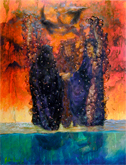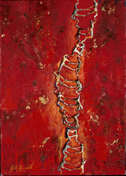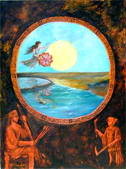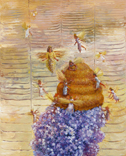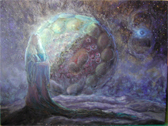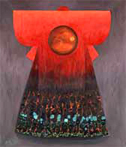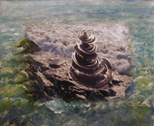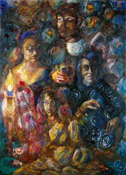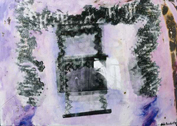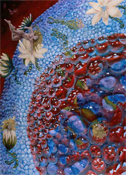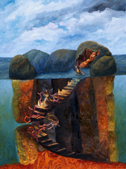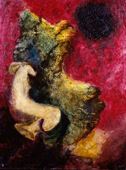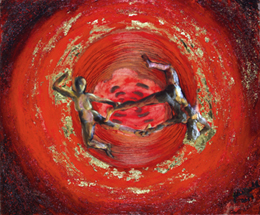
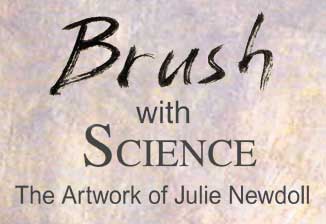
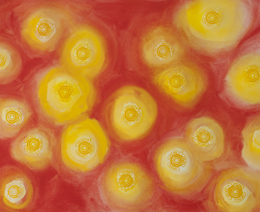
...Julie Newdoll merges life science and culture, myths and molecules in her
paintings, music, journal covers and science games.
Shakespeare:
A Mirror up to Science
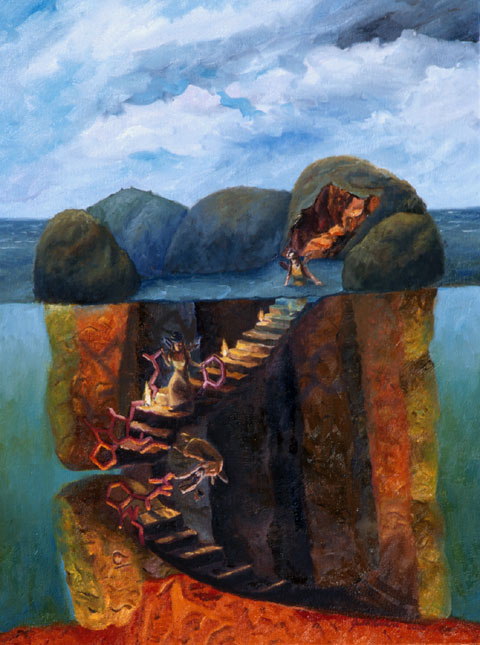
Ishtar was a goddess in the times when dreams were just as important as the waking reality; prophetic and real. Her story is revealed to us on clay tablets(1), the earliest version from around 1,600 B.C, unearthed in modern day Iraq. Written in cuniform, the oldest known written language, her ancient story presented itself to me during my search for an analogy between a most ancient biological gate and a mythological counterpart. This biological gate is found in membrane proteins that allow only water or glycerol to cross the membrane and enter a cell, and has been conserved for over four billion years.
A small handful of amino acids compose this gatekeeping system, and every species which contains a protein for conducting water or glycerol into a cell also contains this gateway package of amino acids. The first structure to be determined for this kind of channel was for a protein called the GLPF receptor (glycerol facilitator protein)(2). This protein is represented here, where the pillars of the channel in the painting mimic the arrangement of the seven helices which compose the GLPF receptor, with two of the helices stripped away to reveal the inside of the channel. The stairway portrays the connections between the helices that allow specific molecules to enter the channel, and the ancient gate is shown in its amino acid structure on the stairway.
In the Ishtar story, her descent into the underworld is strikingly enzymatic. She must pass through seven doors, losing a piece of clothing at each door, until she arrives naked into the underworld. Glycerol is like food for a bacteria, and once it passes through the gates of the GLPF receptor, it enters the cell to be broken down and digested into its various components. Ishtar descends the staircase and passes through the gates to enter the underworld using the same route a glycerol molecule would travel through this structure.
(1) “Myths from Mesopotamia, Creation, The Flood, Gilgamesh and Others”, by Stephanie Dalley, 1989, Oxford University Press, ISBN 0-19-283589-0
(2) “Structure of a glycerol-conducting channel and the basis for its selectivity”, Science, 2000 Oct 20;290(5491):481-6 . Fu D, Libson A, Miercke LJ, Weitzman C, Nollert P, Krucinski J, Stroud RM.
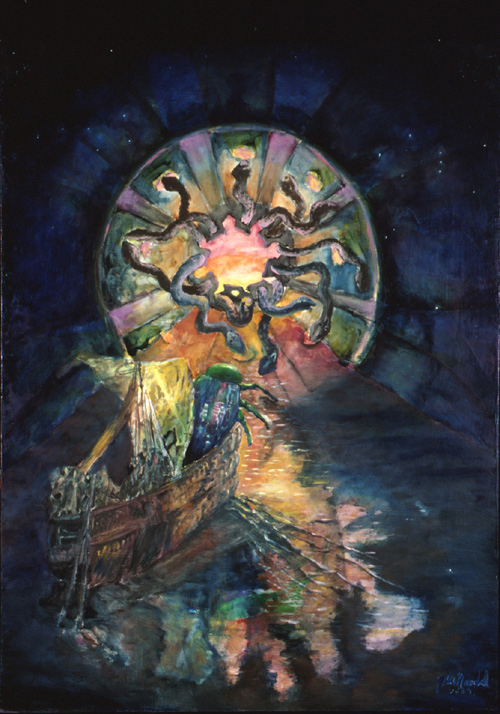
The transportation of Ra through a Vault Protein out of the Night Sky and into the Birth of the Sunrise,egg tempera and oil on board, 33" x 44", 2001. Private Collection. Prints available..
In the ancient Egyptian legend, “The Regions of Night and Thick Darkness”, Ra, the sun king, dies each night and makes a journey in his “Boat of Millions of Years” through the otherworld of the night sky. After traveling through twelve regions of the underworld country, Duat, each guarded by a gate and a terrifying snake, he is once again reunited with his soul in the form of the scarab beetle, Khepera. The sun king is thus alive again, and a new sunrise is born.
This mysterious process of daily transport to create the cycle of night and day is shown here inside of a capsule-like particle composed of proteins called “the vault”. The function of the vault particle is still a scientific mystery, although there is some evidence that it is involved in cellular transport. The structure of the vault is a “hollow, barrel-like structure with two protruding caps and an invaginated waist”. In this painting we are inside of a vault particle looking out through one of its end caps. At the caps of the structure there are 12 RNA strands of a very special type, similar to the telomeres at the endcaps of chromosomes (pieces of DNA which help protect the chromosome and keep the ends from fraying). The night sky was considered a vault by ancient peoples that did not realize the earth was round.
This story may be found in Legends of Ancient Egypt, by M.A.Murray, Dover Publications, Inc., 2000, ISBN 0-486-41137-0. Inspired by the papers Structure of the vault, a ubiquitous cellular component, Lawrence B Kong , Amara C Siva , Leonard H Rome and Phoebe L Stewart , Structure 1999, Vol 7 No 4; and RNA location and modeling of a WD40 repeat domain within the vault, Lawrence B. Kong, Amara C. Siva, Valerie A. Kickhoefer, Leonard H. Rome, and Phoebe L. Stewart , RNA(2000), 6:890–900+
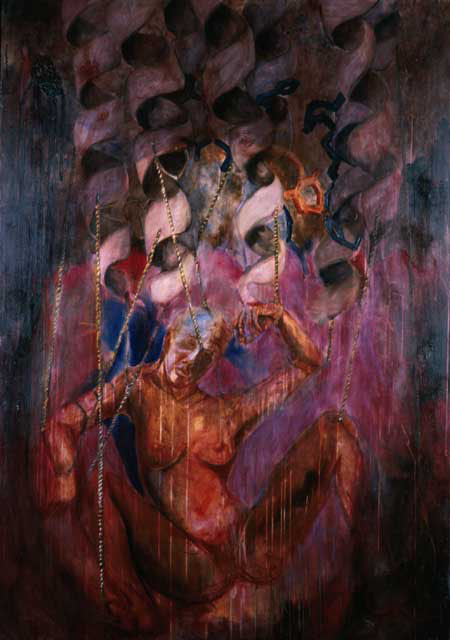
Pheromone Puppet, oil on canvas, 4' x 5', 1994. Available for purchase, $900.
Humans have an area just above their nose called the vomeronasal pit, which may contain pheromone receptors. This receptor would detect airborne chemicals emitted by other people. Other mammals contain such receptors, but it is a matter of debate whether humans have an active vomeronasal organ. The artist feels certain that there is, but we shall see. Such chemicals, or pheromones, are responsible for such phenomenon as women menstruating at the same time, or an unexplained "chemical attraction" for another person. The spirals in the painting show the possible protein structure of the pheromone receptor. It is very likely that there are seven helices which form this structure. Many senses have this seven helix structure. As the actual structure for the pheromone receptor has not yet been determined, a bacterial protein which captures light was used as a model. It also has seven helices, is a receptor, and related to our sense of sight.
Inspired in part by the papers Vomeronasal epithelial cells of the adult human express neuron-specific molecules, Takami S, Getchell ML, Chen Y, Monti-Bloch L, Berliner DL, Stensaas LJ, Getchell TV., NeuroReport 4, 375-378, 1993, and also The Human Skin: Fragrances and Pheromones, Berliner DL, Jennings-White C, Lavker RM. , J. Steroid biochem. Molec. Biol., Vol. 39, No. 4B, pp. 671-679, 1991.
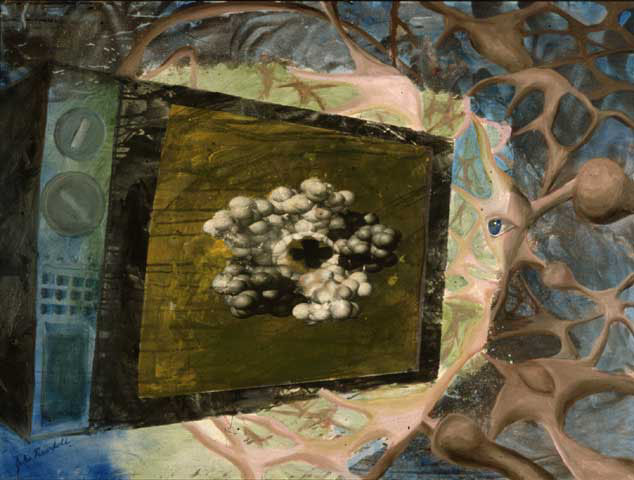
Nerve Eye on Channel Two, mixed media with oil, 40" x 40", 1992, private collection.
Nerve eye on channel two is a nerve ion channel, too. The neurons in our brain have many ion channels, which control the firing of neurons. An ion channel is a barrel shaped protein that allows small molecules, ions, to pass from outside of a cell to inside a cell, or vice versa. The brain contemplates this phenomenon.
Computer generated Ion channel model by Robert M. Stroud and Julie Newdoll.
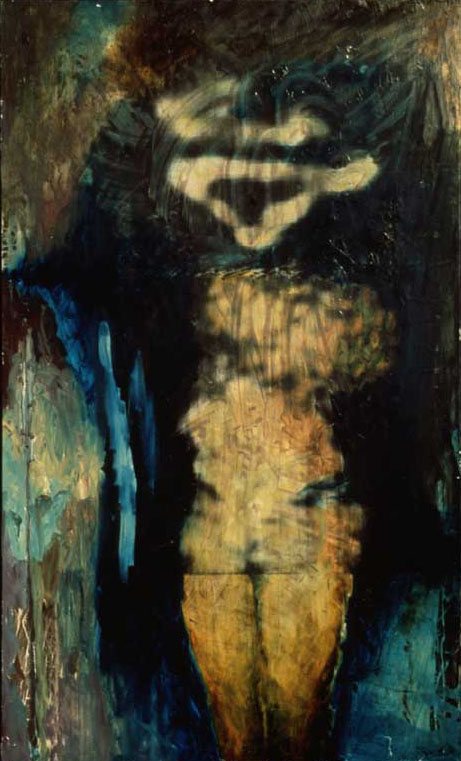
Notch Gene Figure Head, mixed media with oil on canvas, 3.5' x 5', 1993, Not For Sale.
This painting began as a figure from a research paper, which looked very much like a human female figure to me. The triangular "head" is the the "notch gene" stained and photographed under a microscope. The body is the microscope image of the dna. The notch gene is found at the pelvic area of the figure. The legs of the figure were added as part of the painting.
Inspired by a figure in the paper, Precise determination of the molecular limits of a polytene chromosome band: regulatory sequences for the Notch gene are in the interband, Rykowski MC; Parmelee SJ; Agard DA; Sedat JW, Cell 1988 Aug 12;54(4):461-72
Programmed
Cell Death:
Apoptosis
